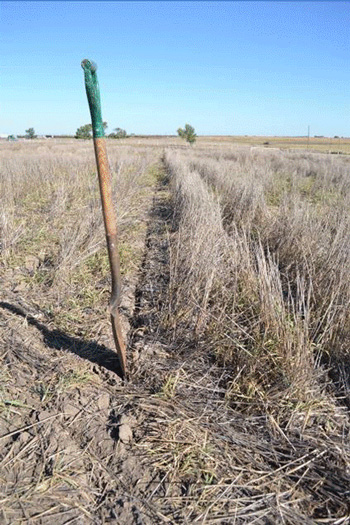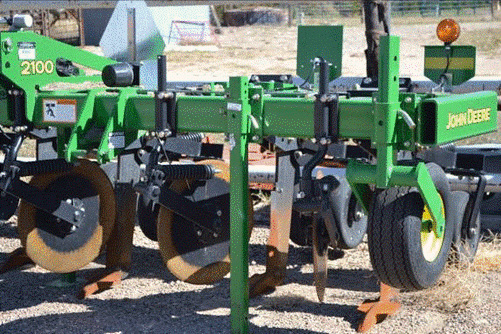Now that row crop harvest is over in Kansas, some farmers might consider performing deep tillage to alleviate compaction. A companion article in this eUpdate provides more information on assessing your soil for compaction zones. Here are a few things to consider:
How deep should the tillage operation occur?
That is best answered by taking a spade or soil probe out in your field and digging a few holes. Ideally, you should dig down to about 18 inches. You are looking for dense layers that restrict plant roots. If you see “platy” soil structure, which looks like many horizontal layers of soil about ¼ to ½ thick in diameter, look to see if the roots have penetrated through this zone in the soil. If the roots have predominantly penetrated this zone, the layer probably isn’t really root-limiting. If you see a lot of roots that are growing horizontally, or if they appear stubby and gnarled, lacking many root hairs, that can also be a sign that the roots are having trouble making it through this layer.
If you see a dense zone that ends at around 8 inches, you’d only want to go about 9 inches deep with the tillage operation. As you double the depth of the tillage operation, you quadruple the power requirement, so going too deep is a waste of time and energy. Also, there is no point in going deeper and potentially damaging the soil profile even further (risks are explained below).
Will deep tillage benefit future crop yields?
In research studies, it is commonly concluded that deep tillage is only beneficial if the zone of compaction is truly root-limiting. If it isn’t, deep tillage probably won’t be of much benefit. The only way to really know is to leave about 3-5 untilled strips through your field and then compare the yields in those areas to the tilled parts of the field next year — easy enough to do if you have a yield monitor and you mark the locations of those untilled strips.
How long does the effect produced by deep tillage last?
Tillage can temporarily loosen soil, but because it breaks natural soil structure into smaller pieces, eventually, tilled soils re-compact and become denser with time. If the field is subsequently conventionally tilled, and particularly if the traffic is not controlled or limited to certain tire track paths, the benefit will only last a few years due to the many trips made across the field with various tillage and other implements. If the field is subsequently no-tilled and traffic is controlled, the effect of a single deep tillage operation might last longer.
Are there any negative side effects of deep tillage?
If tillage is performed when the soil is too wet, the compaction zone could be moved even deeper. To know if the soil is too wet for tillage, try to make a ribbon out of the soil without wetting it. If you can make a texture ribbon, it is too wet. Alternatively, if you can roll out a “snake” of soil by rubbing it between your palms, it’s too wet. This is called “plasticity,” and if the soil is plastic (bendable), it can smear and compact easily. You’ll need your shovel or soil probe to test this to the entire depth that you want to till.
Your goal is to create fracture, so the soil has to be dry enough to shatter, not smear. To see if you’re achieving this, dig between the shanks with a spade and see if the soil is loosened. If you bring up huge clods, the soil isn’t shattering, and it would be better to wait until it is drier. Straight shanks are going to cause the least amount of soil disturbance, as shown in the photos below.


Figure 1. (Top photo) This image was taken 6 weeks after tillage with a ripper designed for minimum surface disturbance as it has straight shanks. The spade could be easily pushed all the way into the soil. The area between the shanks was easy to dig, except in the end rows, where there was a lot of traffic from heavily loaded grain carts. (Bottom photo) This is the implement used in the field described above. Photos by DeAnn Presley, K-State Research and Extension.
Also, remember that certain field areas are probably more compacted than others. Compacted areas might not be ready for deep tillage at the same time as the rest of the field because compacted areas tend to stay wetter for longer. A case in point is a visit to an Ellis County producer’s farm. Soil shattering was observed from deep tillage across the entire 30 inches between the shanks in the “average” part of the field, but in the end rows where the grain cart was driven, excavated clods were about one cubic foot in size, most likely because those more compacted areas of the field were wetter.
Is deep tillage economical?
Only if a root-limiting layer is really present, and even then, it’s not an easy decision because this is a costly operation. Deep tillage requires a lot of power. Deep tillage is slow-going, and the implements are not very wide. As a result, deep tillage requires a lot of time, diesel fuel, and usually a few sheared bolts! Custom rates for tillage operations vary depending on many factors, including location, type of soil, tillage practice, size and shape of field, and the size of equipment. The 2024 custom rates for various types of tillage operations by district are available on the K-State AgManager website at https://www.agmanager.info/sites/default/files/pdf/2024_CustomRates_06-14-24.pdf.
How can you prevent compaction?
Deep compaction is caused by heavy axle loads. Research indicates that axle loads greater than 10 tons can cause compaction as deep as 12 to 18 inches, and many modern implements weigh well over 10 tons per axle. The only way to reduce axle weight is to decrease the load weight or add axles — axle load cannot be reduced by adding more or larger tires, unfortunately. Shifting to continuous no-till can help soils become more resistant to subsequent compaction, and long-term research conducted in the Great Plains shows that no-till is more resistant to compaction at wetter soil moisture levels (Figure 2).

Figure 2. Tilled soils are more easily compacted than those under no-till. Also, no-tilled soils can better withstand machinery traffic at higher water contents compared to conventional and reduced-tilled soils; MF3066 Efficient Crop Water Use in Kansas https://www.bookstore.ksre.ksu.edu/pubs/MF3066.pdf (Source of original data: Blanco-Canqui, et al., 2009. No-till induced increase in organic carbon reduces maximum bulk density of soils. Soil Science Society of America Journal 73:1871-1879).
DeAnn Presley, Soil Management Specialist
deann@ksu.edu
Tags: deep tillage soil compaction